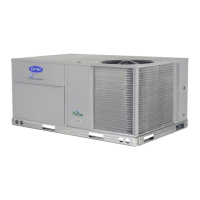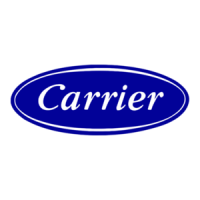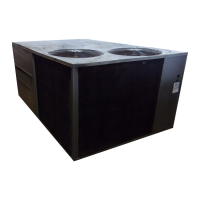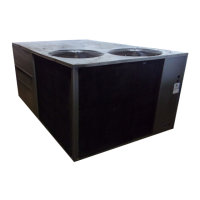45
2. Read and follow instructions on all WARNING,
CAUTION, and INFORMATION labels attached to,
or shipped with, unit.
3. Make the following inspections:
a. Inspect for shipping and handling damages such
as broken lines, loose parts, or disconnected
wires, etc.
b. Inspect for oil at all refrigerant tubing connec-
tions and on unit base. Detecting oil generally
indicates a refrigerant leak. Leak--test all refri-
gerant t ubing connec tions using electronic leak
dete ctor, halide torch, or liquid--soap solution.
c. Inspect all field --wiring and factory--wiring con-
nect ions. Be sure that connections are completed
and tight. Be sure that wires are not in contact
with refrigerant tubing or sharp edges.
d. Inspect coil fins. If dam aged during shipping and
handling, carefully strai ghten fins with a fin
comb.
4. Verify the following conditions:
a. Make sure that condenser--fan blade are correctly
positioned in fa n ori fice. See Condenser--Fan
Adjustment section for more details.
b. Make sure that air filter(s) is in place.
c. Make sure that condensate drain trap is filled
with water to ensure proper drainage.
d. Make sure that all tools and miscellaneous loose
parts have been removed.
START--UP, GENERAL
Unit Preparation
Make sure that unit has been installed in accordance with
installation instructions and applicable codes.
IMPORTANT: Follow the base unit’s start-up sequence
as described in the unit’s installati on instructions:
In addition to the base unit start-up, there are a few steps
neede d to properly start-up the controls. RTU-OPEN’s
Service Test function should be used to assist in the base
unit start-up and also allows verification of output
operation. Controller configuration is also part of start-up.
This is especially important when field accessories have
been added to t he unit. The factory pre-configures options
installed at the factory. There may also be additional
installation steps or inspection required during the start-up
process.
Additional Installation/Inspection
Inspect the field installed accessories for proper
installation, ma king note of which ones do or do not
require configuration changes. Inspec t the RTU-OPEN’s
Alarms for initial insight to any potential issues. Refer to
the following manual: “Controls, Start--up, Operation and
Troubleshooting Instructions.” Inspect t he SAT sensor for
relocation as intended during installation. Inspect special
wiring as directed below.
Return--Air Filters
Ensure correct filters are installed in unit (see Appendix II
-- Physical Data). Do not operate unit without return--air
filters.
Outdoor--Air Inlet Screens
Outdoor--air inlet screen must be in place before operating
unit.
Compressor Mounting
Compressors are internally spring mounted. Do not loosen
or remove com pressor hold down bolts.
Internal Wiring
Check al l electrical connections in unit control boxes.
Tighten as required.
Refrigerant Service Ports
Each unit system has two 1/4” SAE flare (with check
valve s) service ports: one on the suction line, and one on
the compressor discharge line. Be sure that caps on the
ports are tight .
Compressor Rotation
On 3 --phase units with scroll compressors, it is important
to be ce rtain compressor is rotating in the proper
direction. To de termine whether or not compressor is
rotating in the proper dire ction:
1. Connect service gauges to suction and discha rge pres-
sure fittings.
2. Energize the compressor.
3. The suction pressure should drop and the discharge
pressure should rise, as is normal on any start--up.
If the suction pressure does not drop and the discharge
pressure does not rise to normal levels:
4. Note that the evaporator fan is probably also rotating
in the wrong direct ion.
5. Turn off power to the unit and install lockout tag.
6. Reverse any two of the unit power le ads.
7. Re--energize to the compressor. Check pressures.
The suction and discharge pressure leve ls should now
move to their normal start--up levels.
NOTE: When t he compressor is rotating in the wrong
direc tion, the unit will make a n elevated level of noise
and will not provide cooling.
Cooling
Set space thermostat to OFF position. To start unit, turn on
main power supply. Set system selector switch at COOL
position and fan switch at AUTO. position. Adjust
thermostat to a setting below room temperature.
Compressor starts on closure of contactor.
Check unit charge. Refer to Refri gerant Charge section.
50HC

